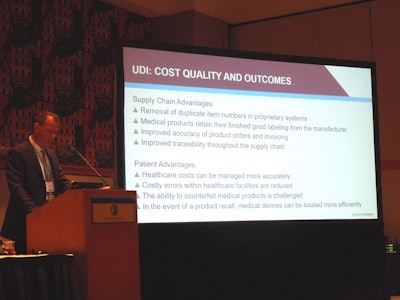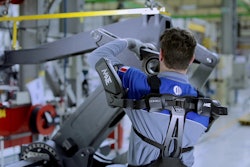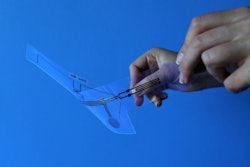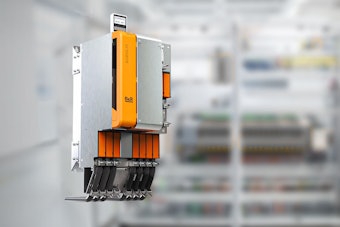In the medical device world, Unique Device Identification, or UDI, is an ongoing topic of discussion at many industry events. Not all medical device supply chain shareholders, however, are on the same page when it comes to implementing UDI as a means of identifying devices through their distribution and usage. The good news is that more medical device firms at all supply chain levels are realizing there are indeed benefits to UDI—not just for their internal processes, but also for patients.
Benefiting patients, of course, is at the heart of UDI implementation, and that was the prevailing theme at an Aug. 13 “Learning Lab” panel discussion at AHRMM18. The event runs Aug. 12-15 at McCormick Place in Chicago.
“Everyone Has a Stake in a Successful UDI Implementation,” included four panelists: Susan Morris, Healthcare Executive, Cerner Corp.; John Kelty, Director of Business Solutions, WL Gore and Associates; Peggy Kolb, Director Materials Management, Beloit Health System; and Christopher Wiekert, MBA, Senior Product Manager, Infor (US) Inc.
Kelty, who noted that Gore counts more than 40 million medical devices implanted worldwide since 1975, said the company is focusing on automation to improve operations. He cited the following supply chain benefits that UDI yields for the company:
• The removal of duplicate item numbers in proprietary systems
• Medical products retain their finished goods labeling from the manufacturer
• Improved accuracy of product orders and invoicing
• Improved traceability throughout the supply chain
Beyond internal benefits, Gore also noted that UDI benefits patients by helping to more accurately manage health care costs, reduce potential health care facility errors, challenge the potential to counterfeit medical products, and efficiently locate medical devices in the event of a recall.
Kolb noted that the Beloit (WI) Health System operates 256 hospital beds and is involved in numerous healthcare areas, which include implants, catheter labs and surgical centers. Her responsibilities include the oversight of purchasing and receiving, inventory control, Central Supply and capital equipment negotiation and procurement.
“The UDI initiative is one of the most important [issues] in health care and patient care today,” she said. “It’s ‘right’ for a lot of reasons: regulatory, supply chain efficiencies, and in the OR for patient outcomes. There’s a need to help manufacturers ensure that medical devices are safe for patients.”
To emphasize that point, she told the audience these devices could be implanted in any of us, and/or in family members, indicating that the focus on patients was central to driving UDI implementation at the Beloit Health System.
That said, Kolb recognized that the most pressing UDI implementation challenges are limited resources and timely database upkeep/management at the point of use.
Wiekert, who is involved in Infor’s ERP Supply Chain Suite of applications, told AHRMM attendees, “Beyond inventory tracking, [the potential for assisting] with recalls is a great reason why UDI is helpful.”
Addressing UDI adoption challenges
Speaking of technology, Morris engaged the panel session audience with a series of interactive questions in which attendees could respond to panel questions via their smartphones. Audience members included professionals from various points along the supply chain, who provided a mix of responses. In this instance, the questions served to address some of the more pressing issues related to UDI implementation. They included the following:
• Which of your companies is using UDI in patient documentation?
• What is the most important outcome of UDI in health care?
• Where is UDI having the greatest impact in your organization?
• What do you see as the greatest opportunity to move health care to full UDI adoption?
At Cerner, Morris serves as a resource for consultants and clients in terms of navigating technology to support a health care organization. She recognized that UDI adoption is challenging. “We need to do a better job educating people in the supply chain, and in teaching clinical staff how to read a barcode.”
Another factor, she pointed out, is that some medical devices are good for years, and may not even have an actual expiration date. In these instances, hospitals don’t want to discard usable devices, even though such older packaging may not include a barcode. And sometimes barcodes just don’t scan. “It’s an evolutionary process,” Morris noted. “We may need to purchase scanners for OR staff.”
UDI involvement and resources
Morris encouraged audience members to become more involved in advancing UDI implementation and future changes, be they hospital providers, manufacturers, regulatory professionals, etc. One specific approach she acknowledged was AHRMM’s Learning UDI Community, a coalition of health care leaders across multiple sectors “whose goal is to develop a common understanding and approach to UDI adoption within the health care setting.”
Said Morris, “It takes a village to make UDI successful. It all comes back to the patient.”
The Association for Health Care Resource & Materials Management (AHRMM) of the American Hospital Association is a membership group for health care supply chain professionals. It strives to “advance health care through supply chain excellence by providing education, leadership, and advocacy necessary for its members to remain at the top of their field. With more than 4,300 members, AHRMM offers numerous opportunities for professionals to reach their highest potential and grow their network.”
According to FDA, Sep. 24, 2018 is an important compliance deadline for several key medical devices matters, including the direct marking of class II devices. Visit the agency’s website for more details on these deadlines, as well as general UDI background details and benefits.























